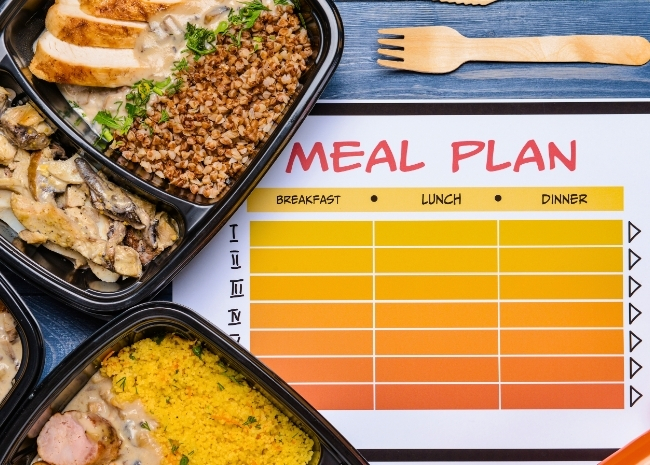
The Beginner’s Guide to Meal Planning
It’s summer.
Routines are loose, days are longer, and whether you live with kids, roommates, a partner—or you’re just trying to feed yourself without burning out—chances are you’re hearing this question more often than you’d like: “What are we eating?”
That’s where meal planning comes in.
Why Meal Planning is Worth It (Especially in the Summer)
Summer tends to shake things up.
Whether it’s kids home from school, travel plans, weekend BBQs, or just hot days when no one wants to cook, the usual food routines go out the window.
That’s where a meal plan helps:
- You’ll spend less time wondering what to make
- Grocery shopping gets easier and faster
- You’ll waste less food
- You can eat more balanced meals without overthinking it
- It reduces decision fatigue (which is real)
Start Here: Simple Steps to Build a Meal Plan
No spreadsheets or apps required. Just a little structure to take the pressure off.
1) Pick a Day to Plan
Pick one day a week to sit down for 20–30 minutes. Sunday works for a lot of people, but it could just as easily be Tuesday evening or Friday morning.
2) Look at Your Week First
Before planning meals, check what you’ve got going on. Any long workdays? Events? Travel? Don’t plan complicated meals for those nights. Keep it flexible.
3) Choose Theme Nights (Optional but Helpful)
Themes can help if decision-making feels exhausting.
Some low-effort examples:
- Meatless Monday
- Taco Tuesday
- Pasta Night
- Build-Your-Own Bowl Night
- Leftovers Day
- Freezer Friday
They’re not rules—just mental shortcuts. Don’t overthink it.
4) The 3-1-1 Method
Not sure where to start?
This super simple formula works for almost anyone:
- Pick 3 meals to cook
- Plan 1 day for leftovers
- Leave 1 night open (takeout, dinner with friends, cereal—whatever)
Suddenly, most of your week is covered with minimal effort.
Real-World Meal Planning Tips No One Tells You
Let’s get into the stuff that actually helps you keep this going beyond Week 1.
1) Start with What You Already Eat
Don’t dive into brand-new recipes unless you’re excited to. Start with meals you already like and know how to make. Build from there.
2) Plan for Lazy Days
Some nights, you’re not going to want to cook—and that’s normal.
Keep 1–2 meals on standby that require basically no effort:
- Pasta + jarred sauce + frozen peas
- Quesadillas or wraps
- Stir fry with frozen veggies and rice
- Instant ramen with a soft-boiled egg
- Frozen dumplings or potstickers
Think of these as your “Plan B” meals. Always good to have.
3) Use What You Already Have
Before writing down new meals, do a quick pantry and fridge check. Got two eggs, half an avocado, and a lonely zucchini? That’s at least one meal. Maybe two.
4) Make a Running List of Favorite Meals
Start building a list of go-to meals you like (and others in your house will actually eat). Over time, you’ll have your own custom rotation to pull from when you’re short on ideas.
5) Don’t Forget the Fun Factor
Meal planning shouldn’t be boring. Mix in a new recipe now and then, plan a picnic dinner, do breakfast-for-dinner on a random Tuesday, or have a “snack board night” with no rules. Food should be enjoyable, not a chore.
Summer-Friendly Meal Ideas (That Don’t Heat Up the House)
Quick & Easy Dinners
- Grilled chicken + corn on the cob + fruit
- Pasta salad with veggies and feta
- Black bean tacos or taco bowls
- Sheet pan gnocchi and summer vegetables
- “Snack dinner” (a mix of cheese, crackers, veggies, hummus, fruit)
No-Cook or Low-Cook Lunches
- Hummus + pita + cucumber slices
- Cold pasta or grain bowls with whatever you’ve got
- Tuna or egg salad wraps
- Caprese salad with bread
- DIY bento box (fruit, nuts, protein, carb, dip)
Smart Summer Snacks
- Cheese sticks or cubes
- Apple slices and nut butter
- Yogurt cups
- Popcorn
- Sliced veggies and hummus
- Trail mix or nuts
- Mini sandwiches or pinwheels
- Leftover fruit from the weekend farmer’s market
Snacking Smarter (for Kids, Adults, and Everyone in Between)
Summer tends to equal snack season.
Whether it’s kids raiding the kitchen or you reaching for chips at 3 p.m., having snack options ready can save money, reduce stress, and help everyone stay full between meals.
— Create a Snack Zone
Set aside a drawer, basket, or fridge shelf with go-to snacks.
It works for everyone—kids, roommates, or just future-you on a snack mission.
— Schedule Snack Breaks
You don’t need to be a toddler to benefit from structured snacking.
Try having a mid-morning and mid-afternoon option ready. It keeps you from hitting that “what am I even craving?” slump where you open the fridge six times.
Final Thoughts
Meal planning doesn’t need to be perfect. It’s not a test. It’s a tool to make life a little easier, whether you’re feeding three kids or just trying to avoid another night of chips and salsa for dinner (hey, we’ve all been there).
Start small. Be flexible. Repeat what works. Skip what doesn’t.
And if all else fails? Toast and a smoothie is still a win.
Your Quick Meal Planning Checklist
- Choose a weekly planning day
- Look at your actual schedule
- Pick 3 simple meals, 1 leftover day, 1 no-plan day
- Prep a few snacks (for everyone’s sake)
- Keep a list of meals you like and repeat them
- Give yourself permission to keep it casual
The Jackson Clinics serves 18 locations throughout Northern Virginia.
Find one near you: thejacksonclinics.com/locations


















